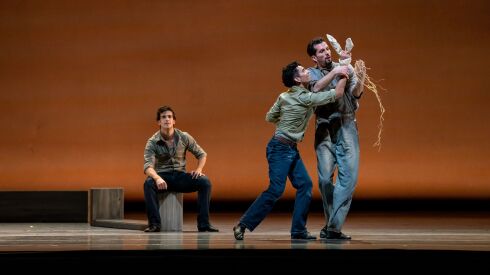
Alberto Velazquez (from left) Xavier Núñez and Dylan Gutierrez are among the cast of the Joffrey Ballet’s world-premiere production of “Of Mice and Men.”
Cheryl Mann
Few stories are more embedded in the American psyche than John Steinbeck’s “Of Mice and Men,” which virtually all middle-school or high-school students read at some point in their English classes.
Published in 1937, John Steinbeck’s famous novella centers on two Depression-era migrant farm workers—Lennie, a good-hearted but mentally disabled giant, and George, his loyal if sometimes disgruntled friend and guardian.
Because of its narrative simplicity and emotional power, this story, which takes a tragic turn when Lennie accidentally kills another worker’s wife, turns out to be well-suited to adaptation as a ballet.
That became clear Wednesday evening when the Joffrey Ballet presented the world premiere of Cathy Marston’s intense, involving dance setting of the book in a program paired with George Balanchine’s “Serenade.” The duo offering runs for nine more performances through May 8.
Marston, a British choreographer whose credits include an adaptation of “Jane Eyre” that the Joffrey Ballet presented in 2019, is adept at conveying character through movement—the sneering aggressiveness of Curley (Fernando Duarte) or the hunched awkwardness of Lennie (Dylan Gutierrez).
After an opening sequence, in which the entire story is foretold in dreamy, fast-action fashion, the action largely follows the book, with one scene blending into the next, with high-energy athleticism, push-off partnering and leg-extended turns propelling the action forward.
The ballet runs about 55 minutes, and it could probably benefit from a slight trim to make the action and storytelling more streamlined and focused. It would also have been nice to get more of a sense of the closeness between George and Lennie, perhaps in a calm moment early on.
Marston’s most inventive and insightful intervention is portraying George with two dancers. They are dressed alike and meant to convey the different, sometimes conflicted sides of the character, one who feels a commitment and almost familial bond to Lennie and the other who wants to be free and independent.
The scenes with the three dancers are the ballet’s focal points, with the Xavier Núñez and Alberto Velazquez turning in powerful, well-matched performances as George, and Gutierrez potently conveying the gawky innocence and child-like impulses of Lennie.
The ballet is set to a largely effective, vaguely roots-tinged score by Academy Award-nominated composer Thomas Newman, with conductor Scott Speck and the Lyric Opera Orchestra performing in conjunction with a recorded track of sound effects and altered instrumental sounds. Piano, guitar and solo violin take the lead with sharp chords and dissonances along the way conveying the darker moods.
Demonstrating the Joffrey’s impressive versatility, perhaps its greatest strength, the evening opened in an entirely different realm emotionally, stylistically and aesthetically. The company presented its first-ever performance of “Serenade” (1935), the first work created in the United States by George Balanchine, arguably the most distinguished choreographer of the 20th century.
This upbeat, vibrant work for 26 dancers, with the women in flowing blue tutus, was built around a class in dance technique and was originally set on students. It showcases some of the trademark qualities of Balanchine’s choreography, including speedy footwork, interweaving, ever-evolving patterns, and use of the corps de ballet as not just decoration but as integral parts of the ballet.
There are many iconic moments in “Serenade,” none more so than the opening, which features 17 dancers in a double-diamond pattern standing serenely with one arm raised gently to the right with the palm out. After a few gradual changes in arm position, the women snap their parallel feet into standard first position—a shift that remains startling no matter how many times one sees this work.
Even though this ballet is more than 80 years old, it feels utterly contemporary. There is something eminently satisfying and reassuring about watching this piece, where every gesture, every step feels just right. That is a definition of a classic, which this work most definitely is.
The dancing in this work was universally strong with the speed, precision and elegance this work demands. Stand-out individual performances include Gayeon Jung and Stefan Goncalvez as the soloists in the waltz section and the spunky presence and nimble footwork of Valeria Chaykina.
The pairing of these two very different ballets, one narrative and one abstract, one grim and one upbeat, is unquestionably jarring. One suspects that these striking contrasts, as well as the proportional emphasis on women in “Serenade” and men in “Of Mice and Men,” were the very reasons the two were put together, and, in the end, the juxtaposition works.
from Chicago Sun-Times - All https://ift.tt/fSCwHpJ

No comments:
Post a Comment